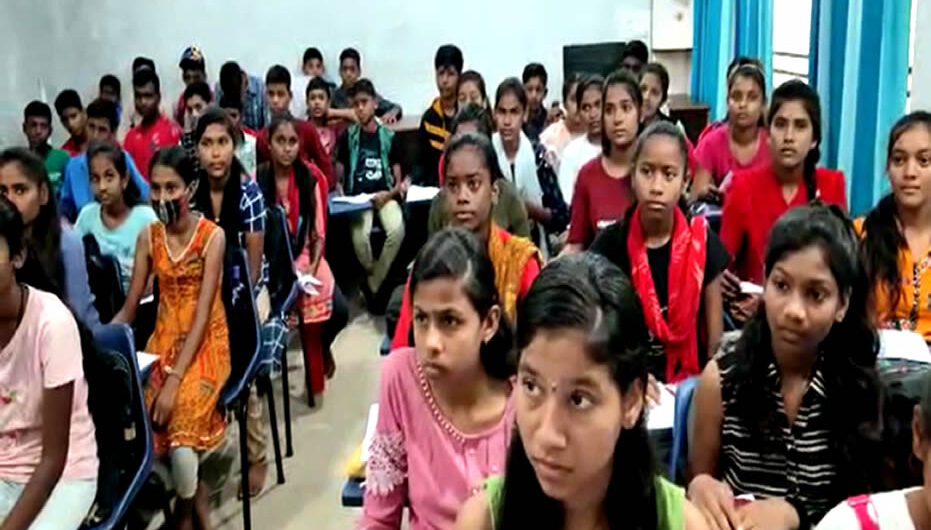
Class 10th & Class 12th Coaching
Improving access to education, counseling of students and parents, innovations in classroom teaching and learning process can aid the condition
When an unknown printer took a galley of type and scrambled it to make a type specimen book. It has survived not only five centuries, but also the leap into electronic typesetting, remaining essentially unchanged. Aelltes port lacus quis enim var sed efficitur turpis gilla sed sit amet finibus eros.


Given the evident benefits of a basic education, why do so many children in so many countries fail to get one? According to economic theory, a lack or shortage of a good or service that is clearly desirable stems from either a failure of demand or a failure of supply. That is, there are demand-side and supply-side impediments.
Cost is one obvious reason why demand for education might be low, given that poor families must meet their essential needs—food and shelter—first. In addition to tuition, books, and school supplies, there may be expenses for transportation and clothing. Some parents might be able to afford an education for their children if they could spread the cost over several years, but many poor people in low-income countries do not have access to credit.
Demand for education may not be present because of the opportunity costs of educating children: parents may prefer that their children work to supplement household income, do household chores, or care for sick family members. In African countries afflicted by AIDS, children may stay out of school to care for sick parents or orphaned siblings. Opportunity costs make even free schooling unaffordable for some families.
Also affecting demand for education is its perceived value. Parents may not have enough information to assess the return on an investment in their children’s education accurately, or they may see the return—sometimes correctly—as too low to justify the cost, perhaps because of the poor quality of the education available to them. They may believe that jobs in the local economy do not require academic skills or that getting a job depends more on personal connections than on skill. They may feel that more competitive urban job markets are too far from community and family to consider. Or they may simply be unaware of the opportunities that exist, especially if they are uneducated themselves. If they live in a community that devalues education or frowns upon educating girls, they may be reluctant to violate social norms.
Mexico’s Progresa program, for example, has cut the cost of attending school by more than half, but enrollment has risen only 10 percent. Under the program, the central government makes payments directly to village officials, who distribute them to female household heads—conditional on their sending their children to school and taking them to clinics for preventive health care. The income transfers amount to negative user payments. In countries like Mexico, where weak demand for education is not attributable to cost, school attendance will not improve until cultural barriers and prejudices are overcome and the higher opportunity costs for girls than for boys are addressed.
There may be a failure of supply for the reasons laid out above: a government may lack sufficient resources to provide educational services or be administratively incapable of channeling resources to the schools that need them. Government-financed schools may exist in urban areas but not in rural areas or may vary greatly in quality. Or publicly financed schools may be a low priority if the country’s economic and political elites send their children to private schools. Public resources may be diverted from primary education to institutions of higher education that serve the governing elite or shifted out of education altogether and into other projects—say, military buildup—favored by elites seeking to protect their interests.
Corruption is another reason poor children in poor countries may not have access to quality government-financed schools: government officials may shun spending on schools in favor of big-ticket items such as defense or road construction, for example, since funding for them is easier to divert and such projects are likelier to involve kickbacks.
Foreign donors—aid tends to account for a large share of poor countries’ budgets—also seem to favor capital spending over recurring school expenses like salaries and textbooks.
Pros and cons of user payments
It is important to distinguish between the factors influencing the demand for and supply of education. User payments are less likely to increase school attendance when low enrollment is due to a failure of demand than when it is due to a failure of supply. Obviously, when the problem is a failure of supply because a government lacks the means or will to build or staff schools for children from poor families, user payments are one way parents can provide an education for their children. Of course, demand-side influences make user payments ineffective. If parents are unwilling or unable to put their children in school when education is free, they will not send their children to school when they are obliged to pay for it out of their own pockets.
There is, however, one qualification: user payments may increase the quality of education, motivating parents who were previously unwilling to pay for their children’s education to do so. Studies have confirmed that user payments increase demand for schooling if they lead to academic and other improvements. For example, at first, school attendance declined in rural Mali when school fees were raised, but this decline was more than offset by the rise in attendance that followed the construction of new schools closer to rural communities and the realization by parents that the quality of the schools had improved.
If demand is inadequate because parents are misinformed about the true value of education for their children, user payments may have a “demonstration effect”: when user payments allow more children to go to school, gain skills, and ultimately find jobs, parents of other children may be persuaded that schooling is worthwhile.
Moreover, when parents are required to pay for their children’s education, they are more likely to monitor teacher performance to be sure they are getting their money’s worth, so a virtuous circle is created. A study in the Philippines found that primary schools that relied more heavily on local funding (both from municipal governments and from user payments to parent-teacher associations) tended to be more cost effective. By shifting education financing to the local level, user payments can improve school management. Schools that are accountable to the local community—and to parents, specifically—have a greater incentive to provide a high-quality education, even though corruption may exist at the local level as well as at the national level. Put simply, it is easier for parents to watch over local officials and to take collective action against them if need be. In the end, if payment is voluntary and schools do not perform satisfactorily, parents can take their children out of school, and school administrators will lose some of the funding out of which their own salaries are paid.
Malawi and Uganda Uganda moved most of the way toward free universal primary education in 1997, when it waived tuition for up to four children per household. Families remained responsible for school supplies and contributions to construction, as in Malawi, and had to purchase uniforms and pay final examination fees as well. Uganda did better than Malawi, however, in preparing for the influx of new students. The government doubled the share of recurrent government spending targeted to primary education and used external aid to train new teachers, build classrooms, and purchase teaching materials. Even so, educational quality has fallen, with high pupil-teacher and pupil-classroom ratios and inadequate materials, and net enrollment has declined, from 85 percent in 1997 to 77 percent in 2000. Gender biases are still reported, as in Malawi. The experiences of these two countries demonstrate that universal public education cannot be achieved simply by abolishing fees and opening classroom doors. Obstacles arise on both the demand and the supply sides. Education can still be costly for the poor, thus discouraging enrollment, especially when maintaining quality is a problem. Maintaining quality, in turn, is not just a matter of increasing spending; good planning, implementation, and monitoring are also necessary. Achieving the goal of universal school attendance in both countries will require measures to relieve poor parents of all education-related costs, perhaps through a system of income transfers. |
User payments are a means of overcoming a political bias toward urban elites at the expense of the rural poor. They enable poor parents to pay directly for their own children’s education instead of subsidizing, through their taxes, the education of rich children. While the ideal would be for the rich to subsidize education for the poor through progressive taxation, in reality, the opposite often occurs; user payments can prevent such an unfair outcome.
Educational reform based on user payments may even generate a virtuous political circle. As more people become better educated, they seek greater democratic participation for themselves and greater accountability from their government. It is not inconceivable that, in some countries, this is precisely why the existing regime opposes educational reform that would provide all children with a quality education—or any education at all.
In countries where public finance for schools is not available because of tax evasion, user payments may restore the link between money paid out and services received. That is, people may be prepared to pay for schools because they can see what they are getting for their money, whereas they may evade taxes because they perceive, correctly, that their taxes will be appropriated by corrupt officials and not reach the schools.
That said, user payments are not a panacea. Education that is publicly financed and free to users is both more equitable and more inclusive than education that is paid for by parents. If school attendance is compulsory, a required user payment is a regressive tax—that is, the burden of paying the tax is greatest for the households with the lowest incomes. In the simplest arrangement, the user payment is a fixed amount per child. Such a payment represents a larger share of a poor family’s income than of a rich family’s; as a share of disposable income, the burden on the poor family is even greater.
Although user payments allow parents to finance education for their children when quality publicly financed schooling is not available, voluntary school attendance (that is, attendance contingent on payment) may lead some parents not to send their children to school. In general, the higher the fee, the more likely it is that families will decide not to educate their children or be forced to make choices about which of their children to educate. Some children may therefore not receive an education. Such exclusion is unfair. The alternative may be even worse, however; in the absence of user payments in countries whose governments are unable or unwilling to provide free schooling, all poor children may be excluded from getting an education.
When children cannot go to school because their parents cannot afford user fees, not only is the situation unfair and socially unjust but it can also be economically inefficient. Many school costs—such as the physical infrastructure and teacher salaries—are fixed, and allowing an additional child to attend would not increase them. This is especially true in rural areas in low-income countries, where the one-room schoolhouse with one teacher and one chalkboard is a common sight. It costs little or nothing to put one more child into such a school. Of course, quality will decline after some point, as the teacher’s attention is divided among more pupils.
In principle, a government could monitor the financing of schools through user payments and make the payments progressive by exempting poor families or basing payment on income. This, however, means involving the government bureaucracy—whose very inadequacies forced many parents to assume the responsibility for their children’s schooling in the first place—in the school system. A small community usually does a better job of monitoring itself. Members tend to know about their neighbors’ economic circumstances. The information they possess about each other can help keep a system of personalized user payments honest, deterring those who might, without cause, seek special treatment. Community ties can thus support a rudimentary insurance system, so that families suffering an economic hardship, such as the disability of an income earner, can continue, with their neighbors’ help, to send their children to school, countering the exclusion from schooling that can result from voluntary user payments.
Because children are entitled to a free, quality, basic education that does not depend on their parents’ willingness or ability to pay for their education, user financing of schools is a temporary solution until the government is able to exercise its responsibility. The success of user payments should not be interpreted by governments as an indication that they have been absolved of this responsibility.
Conclusions
User payments for basic education should never be more than a temporary solution: the ideal arrangement and the appropriate goal of education policy remain universal education financed by government out of public revenues. User payments are undesirable because they are a regressive tax when school attendance is compulsory. Voluntary user payments are undesirable because children are excluded from schooling if their parents are unable or unwilling to pay school fees.
The effectiveness of user payments will depend on whether the reasons children are not in school are demand-side or supply-side. If children are unschooled because of a lack of demand resulting from their parents’ poverty or information problems or a social bias against educating girls, imposing user payments cannot be expected to increase school enrollment—unless the revenues from user payments improve school quality sufficiently to overcome demand-side impediments.
To register for this event email your details to info@p4foundation.in

